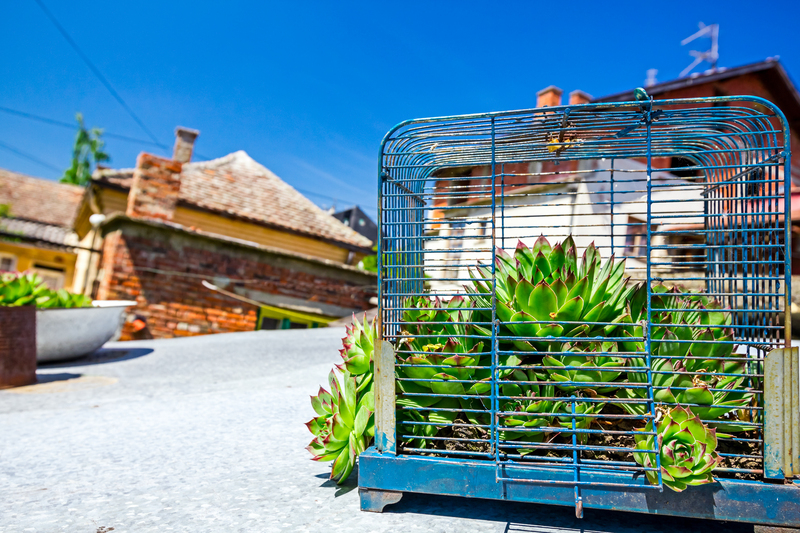Easy-to-Follow Ways to Lightning-Proof Your Garden
Posted on 26/08/2025
Easy-to-Follow Ways to Lightning-Proof Your Garden
Gardens are places of tranquility, vibrant growth, and natural harmony. Yet, with every season comes a new set of challenges, one of the most dramatic being thunderstorm activity. Lightning strikes can spell disaster not only for your garden's aesthetic appeal but also for the safety of your home and family. In this comprehensive guide, we'll explore practical and easy-to-follow techniques for lightning-proofing your garden, ensuring that both your landscape and your loved ones stay safe, no matter what the weather brings.

Understanding the Risks of Lightning in Gardens
During a thunderstorm, lightning strikes are more common than many gardeners expect. They can ignite fires, damage trees, destroy electrical equipment, and even pose life-threatening risks to both humans and pets. Recognizing these hazards is the first step in creating a safer outdoor space. Lightning-proofing your landscape doesn't just make sense; it's an essential part of responsible gardening.
Why Should You Lightning-Proof Your Garden?
- Protects valuable trees and plants from irreversible damage caused by lightning strikes.
- Reduces fire risks that may threaten your home and neighborhood.
- Promotes safety for family, friends, and pets.
- Safeguards outdoor electrical systems and garden lighting from power surges.
Common Effects of Lightning Strikes on Gardens
- Scorched and split trees - Large, isolated trees are lightning magnets and may suffer bark splits or even shatter.
- Power surges - Nearby electrical equipment, pumps, or lighting can be fried by indirect strikes.
- Fires - Dry brush and mulch can ignite, leading to fast-spreading garden and even house fires.
- Soil damage - Sudden heating and electrification may alter soil chemistry and harm plant roots.
- Hazards to wildlife and humans - Both direct and indirect strikes can be fatal.
Top 10 Easy-to-Follow Ways to Lightning-Proof Your Garden
Ready to shield your green space from the dangers of electrical storms? Here are 10 practical, easy-to-follow methods to lightning-proof your garden and reduce the risk of damage.
1. Identify and Protect Vulnerable Trees
Tall, solitary trees are prime targets for lightning. Oak, pine, poplar and similar species with broad canopies or deep root systems are especially at risk. To lightning-proof your yard trees:
- Inspect trees for existing damage, like cracks or dead branches, which can make them more susceptible.
- Install a tree lightning protection system (copper conductor from top to ground rod) on significant, high-value trees.
- Prune deadwood regularly to reduce potential fire fuel.
2. Use Ground Rods to Disperse Electric Charge
A ground rod system helps channel lightning's powerful energy safely into the earth. For garden lightning safety, consider:
- Embedding copper or galvanized steel rods at least 8 feet into moist soil, near vulnerable trees or structures.
- Connecting rods with heavy-gauge wire that runs unobstructed from canopy to soil.
- Maintaining clear paths for the grounding system to function during storms.
3. Keep Outdoor Electrical Systems Safe
Water features, pond pumps, and landscape lighting are all at risk. Lightning-proof your garden's electrical systems with these tips:
- Install weatherproof surge protectors on all outdoor outlets and junction boxes.
- Unplug non-essential equipment before storms when possible.
- Use GFCI (Ground Fault Circuit Interrupter) outlets for added safety.
- *Bury wiring underground* to reduce exposure to direct strikes.
4. Avoid Planting Lightning Magnets Near Homes
Some plants and trees attract lightning more than others. To further lightning-proof garden borders:
- Avoid placing tall trees or metal trellises next to buildings, patios, and playgrounds.
- Choose lower-growing plants and hedges near living areas.
- Consider diversified planting rather than single, high-profile specimens close to your house.
5. Use Mulch Carefully
Dry organic mulch can catch fire easily if a lightning strike hits nearby. To further lightning-proof your garden beds:
- Select fire-resistant mulch options (like gravel, rubber, or stones) near structures.
- Avoid piling mulch too thick, minimizing fire risk.
- Regularly moisten mulch in dry conditions, especially during storm season.
6. Prune Trees for Reduced Risk
Regular maintenance helps keep trees healthy and safe. For best lightning-proof garden management:
- Trim back overhanging limbs from roofs and electrical lines.
- Remove deadwood and diseased branches that increase risk of fire or collapse.
- Contact a certified arborist for advice on major pruning or tree removal.
7. Install Lightning Protection Systems
Lightning rods and conductors have protected homes and gardens for generations. To create a comprehensive lightning-proof landscape system:
- Install UL-listed lightning rods on garden sheds, gazebos, and high structures.
- Connect to a network of ground rods for maximum effectiveness.
- Perform annual maintenance checks to ensure your system works.
8. Design Safe Outdoor Gathering Areas
Reduce the chance of harm by choosing safe locations for patios and seating:
- Keep outdoor living spaces away from tall trees, metal poles, or structures likely to attract strikes.
- Install non-conductive furniture (plastic, resin, wood) instead of metal when possible.
- Educate family and visitors about moving indoors during thunderstorms.
9. Plan for Stormwater Management
Heavy rain often accompanies lightning storms. Prevent further risks by lightning-proofing your garden's drainage:
- Shape planting beds for gentle runoff away from tree roots and foundations.
- Use rain gardens and permeable paving to help absorb sudden influxes of water.
- Keep gutters and downspouts clear for effective water dispersal.
10. Stay Alert and Informed
No garden is completely storm-proof, but staying ahead of the weather is half the battle:
- Use weather apps and alert services for real-time storm tracking.
- Have an emergency plan for family and pets during lightning events.
- Move vulnerable equipment indoors at the first sign of severe weather.
Choosing the Right Lightning Protection System for Your Garden
Selecting a lightning protection system should depend on your unique landscape, budget, and level of risk. Here are popular solutions for lightning-proofed gardens:
- For single trees: A sole copper conductor running from the highest point down to a deep ground rod.
- For homes with gardens: Integrate building and landscape protection -- rods on rooftops, conductors to the ground, and interconnected grounding systems.
- For large properties or arboretums: Networked lightning protection grids, custom-engineered for maximum coverage.
- For DIYers: Simple ground rods and annual maintenance, always following safety standards.
For best results, consult a licensed electrician or certified arborist. They provide tailored advice for lightning-proofing garden areas based on local climate, soil condition, and property layout.
Fire-Resistant Gardening: Added Protection Against Lightning
Integrating fire-smart landscaping techniques can significantly mitigate fire risks after a lightning strike. Try these strategies:
- Create defensible space: Maintain a buffer zone of low, irrigated plants near the house.
- Avoid highly-flammable species such as juniper and pine close to structures.
- Replace wood mulch with rock or crushed granite in key areas.
- Install fire breaks using gravel, pathways, or mowed turf.
Lightning Safety Tips for Gardeners
- Never work outdoors during a thunderstorm. If you hear thunder, go inside immediately.
- Keep tools and metal objects indoors when storms are forecasted.
- Educate all family members on recognizing lightning risks and practicing safe behaviors.
- If caught outdoors, avoid open areas, tall trees, and metal structures.
The Science Behind Lightning-Proof Gardens
Understanding why certain features attract lightning can help you make better landscaping decisions:
- Height and isolation: The tallest object in an open area is the most likely to be struck.
- Conductivity: Metal structures, wires, and wet wood conduct electricity efficiently.
- Moisture: Damp soil and foliage can increase the spread of electrical current.
By limiting these factors, you help direct dangerous electrical energy safely away from vulnerable spots, effectively lightning-proofing your landscaping.

Frequently Asked Questions
How often should I inspect my garden's lightning protection system?
Check all rods, conductors, and connections annually, especially before storm season. After strong storms, inspect for visible damage.
Can lightning protection be installed as a DIY project?
Basic ground rods and tree conductors can be installed by experienced DIYers, but always follow local electrical codes. For advanced systems or homes, consult professionals.
Is there a way to make my entire garden fully lightning-proof?
No system is 100% effective, but the combination of physical barriers, smart landscaping, and fire safety greatly reduces risks and potential damage.
Conclusion: Protect Your Garden and Family Year-Round
Nature's fury is unpredictable, but your response doesn't have to be. Using these easy-to-follow lightning-proofing strategies, you can safeguard trees, prevent fire, and keep everyone safe during thunderstorms. Whether you install a comprehensive system or simply change some planting habits, every step counts towards a safer, more resilient garden.
Stay prepared, stay informed, and enjoy your lightning-proof landscape year-round!



